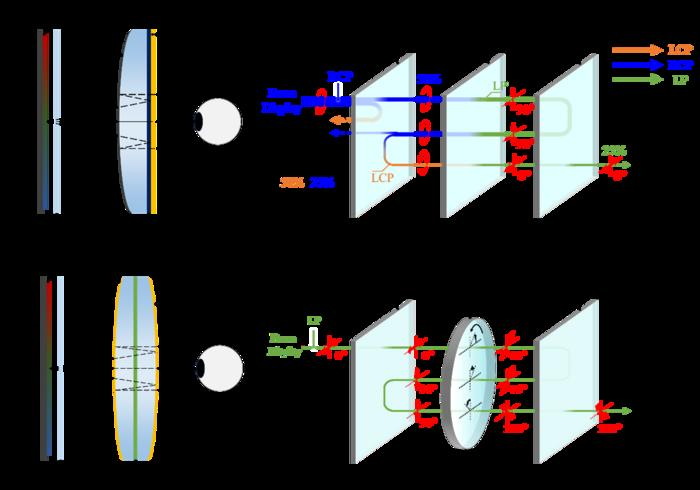Recent research published in Opto-Electronic Advances discusses how unique pancake optics can transform next-generation VR and MR displays.

Working principle of the conventional and novel pancake optics systems. (a) configuration of the conventional pancake optics. (b) polarization conversion process in the conventional pancake optics. (c) configuration of the novel pancake optics. (d) polarization conversion process in the novel pancake optics. Image Credit: Opto-Electronic Advances
Beyond the limitations of conventional flat panel displays, augmented reality (AR), virtual reality (VR), and mixed reality (MR) have broadened our perception and ushered in more intimate human-digital interactions.
The metaverse, digital twins, and spatial computing are just a few of the fascinating new possibilities that this evolution has opened up. These technologies have found widespread use in a variety of industries, including smart manufacturing, navigation, gaming, entertainment, healthcare, and education and training.
Compact and elegant formfactors, light weight, and low power consumption are critical requirements for AR, VR, and MR displays to become truly wearable for extended periods of time. In recent years, polarization-based folded optics, also known as pancake optics, have become a major advancement for small and lightweight virtual reality headsets such as Apple Vision Pro and Meta Quest 3.
This is in contrast to Fresnel and refractive lenses. A VR display with such pancake optics has a significantly lower volume, which raises the headset's center of gravity. However, the maximum efficiency is just 25 % due to the significant optical loss caused by the used half mirror. Consequently, a novel optical construction that can fold similarly to a pancake lens while there is an urgent requirement even without the optical loss.
The power consumption of AR, VR, and MR displays, light engines, and imaging optics have all been thoroughly investigated by the researchers. The study proposes a revolutionary pancake optics system that maintains excellent efficiency while lowering the volume of VR and MR screens.
The growing need for wearable VR/MR headsets that are both aesthetically pleasing and comfortable for prolonged use is what spurred this research. Current VR headsets with traditional pancake optics suffer from issues like low optical efficiency, which raises the headset's temperature impact, and limited battery life because of the significant optical loss caused by the half mirror.
Only around 25 % of the light from the display panel reaches the observer's eye (assuming no additional loss). However, the maximum optical efficiency is further decreased to 12.5% if the microdisplay produces unpolarized light. The light that is not being used will either be absorbed by the headset, increasing the heat effect, or it will become stray light and deteriorate the quality of the image.
To overcome this difficulty, the innovative pancake optics system introduces a theoretically lossless design that places a Faraday rotator—a nonreciprocal polarization rotator—between reflective polarizers.
The nonreciprocal polarization rotator in this system is essential for folding the optical pathways. The nonreciprocal polarization rotator rotates the linearly polarized light regardless of the optical wave's propagation direction, in contrast to reciprocal polarization rotators (such as half-wave plates). Thus, a net rotation of 2θ is obtained from a round trip of forward and backward propagations via the nonreciprocal polarization rotator.
To confirm its optical efficiency and folding capability, preliminary tests were carried out using a laser source and a micro-OLED panel. Due to the non-existence of an anti-reflection (AR) coating and the less-than-ideal performance of the used reflective polarizers, the observed optical efficiency is approximately 71.5%.
Utilizing AR coating and high-performance reflective polarizers, the optical efficiency is increased to 93.2 %, nearly meeting the theoretical estimate. In addition, this innovative pancake optical system analyzes four categories of potential ghost pictures.
New techniques to improve the contrast ratio of the image are suggested by determining the underlying source of these ghost images. Furthermore, a multi-layer construction is suggested to increase the Faraday rotator's bandwidth in order to support full-color displays.
A broadband spectral response can be obtained using three sequences of nonreciprocal polarization rotators and quarter-wave plates. The study analyzes and discusses a few potential thin-film magneto-optics material choices to attain a wide field of view and a genuinely compact formfactor.
All things considered, these demos highlight how a revolutionary pancake optics system with a lightweight, compact form factor and low power consumption could completely transform next-generation VR and MR displays.
Furthermore, the urgent requirement for a thin-film Faraday rotator with a large Verdet constant in the visible range, magnetless, and transparency is anticipated to spur future efforts in the development of magneto-optic materials.
Journal Reference
Ding, Y., et.al., (2024). Breaking the optical efficiency limit of virtual reality with a nonreciprocal polarization rotator. Opto-Electronic Advances. doi.org/10.29026/oea.2024.230178.